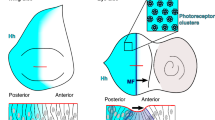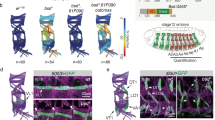Abstract
Morphogens are secreted signalling molecules that govern many developmental processes1. In the Drosophila wing disc, the transforming growth factor β (TGFβ) homologue Decapentaplegic (Dpp) forms a smooth gradient and specifies cell fate by conferring a defined value of morphogen activity. Thus, neighbouring cells have similar amounts of Dpp protein, and if a sharp discontinuity in Dpp activity is generated between these cells, Jun kinase (JNK)-dependent apoptosis is triggered to restore graded positional information2,3. To date, it has been assumed that this apoptotic process is only activated when normal signalling is distorted. However, we now show that a similar process occurs during normal development: rupture in Dpp activity occurs during normal segmentation of the distal legs of Drosophila. This sharp boundary of Dpp signalling, independently of the absolute level of Dpp activity, induces a JNK—reaper-dependent apoptosis required for the morphogenesis of a particular structure of the leg, the joint. Our results show that Dpp could induce a developmental programme not only in a concentration dependent manner, but also by the creation of a sharp boundary of Dpp activity. Furthermore, the same process could be used either to restore a normal pattern in response to artificial disturbance or to direct a morphogenetic process.
This is a preview of subscription content, access via your institution
Access options
Subscribe to this journal
Receive 12 print issues and online access
$209.00 per year
only $17.42 per issue
Buy this article
- Purchase on SpringerLink
- Instant access to full article PDF
Prices may be subject to local taxes which are calculated during checkout





Similar content being viewed by others
References
Teleman, A. A., Strigini, M. & Cohen, S. M. Shaping morphogen gradients. Cell 105, 559–562 (2001).
Adachi-Yamada, T., Fujimura-Kamada, K., Nishida, Y. & Matsumoto, K. Distortion of proximodistal information causes JNK-dependent apoptosis in Drosophila wing. Nature 400, 166–169 (1999).
Adachi-Yamada, T. & O'Connor, M. B. Morphogenetic apoptosis: a mechanism for correcting discontinuities in morphogen gradients. Dev. Biol 251, 74–90 (2002).
Rauskolb, C. The establishment of segmentation in the Drosophila leg. Development 128, 4511–4521 (2001).
Jiang, C., Lamblin, A. F., Steller, H. & Thummel, C. S. A steroid-triggered transcriptional hierarchy controls salivary gland cell death during Drosophila metamorphosis. Mol. Cell 5, 445–455 (2000).
Cashio, P., Lee, T. V. & Bergmann, A. Genetic control of programmed cell death in Drosophila melanogaster. Semin. Cell Dev. Biol. 16, 225–235 (2005).
Hay, B. A., Wolff, T. & Rubin, G. M. Expression of baculovirus P35 prevents cell death in Drosophila. Development 120, 2121–2129 (1994).
Brand, A. H. & Perrimon, N. Targeted gene expression as a means of altering cell fates and generating dominant phenotypes. Development 118, 401–415 (1993).
White, K. et al. Genetic control of programmed cell death in Drosophila. Science 264, 677–683 (1994).
Martin-Blanco, E. et al. puckered encodes a phosphatase that mediates a feedback loop regulating JNK activity during dorsal closure in Drosophila. Genes Dev. 12, 557–570 (1998).
Jockusch, E. L., Nulsen, C., Newfeld, S. J. & Nagy, L. M. Leg development in flies versus grasshoppers: differences in dpp expression do not lead to differences in the expression of downstream components of the leg patterning pathway. Development 127, 1617–1626 (2000).
Niwa, N. et al. Correlation of diversity of leg morphology in Gryllus bimaculatus (cricket) with divergence in dpp expression pattern during leg development. Development 127, 4373–4781 (2000).
Edwards, C. J. & Francis-West, P. H. Bone morphogenetic proteins in the development and healing of synovial joints. Semin. Arthritis Rheum. 31, 33–42 (2001).
Tanimoto, H., Itoh, S., ten Dijke, P. & Tabata, T. Hedgehog creates a gradient of DPP activity in Drosophila wing imaginal discs. Mol. Cell 5, 59–71 (2000).
Entchev, E. V., Schwabedissen, A. & Gonzalez-Gaitan, M. Gradient formation of the TGF-β homolog Dpp. Cell 103, 981–991 (2000).
Teleman, A. A. & Cohen, S. M. Dpp gradient formation in the Drosophila wing imaginal disc. Cell 103, 971–980 (2000).
Belenkaya, T. Y. et al. Drosophila Dpp morphogen movement is independent of dynamin-mediated endocytosis but regulated by the glypican members of heparan sulfate proteoglycans. Cell 119, 231–244 (2004).
Haerry, T. E., Khalsa, O., O'Connor, M. B. & Wharton, K. A. Synergistic signaling by two BMP ligands through the SAX and TKV receptors controls wing growth and patterning in Drosophila. Development 125, 3977–3987 (1998).
Nellen, D., Burke, R., Struhl, G. & Basler, K. Direct and long-range action of a DPP morphogen gradient. Cell 85, 357–368 (1996).
Bishop, S. A., Klein, T., Arias, A. M. & Couso, J. P. Composite signalling from Serrate and Delta establishes leg segments in Drosophila through Notch. Development 126, 2993–3003 (1999).
de Celis, J. F., Tyler, D. M., de Celis, J. & Bray, S. J. Notch signalling mediates segmentation of the Drosophila leg. Development 125, 4617–4626 (1998).
Rauskolb, C. & Irvine, K. D. Notch-mediated segmentation and growth control of the Drosophila leg. Dev Biol 210, 339–350 (1999).
Casares, F. & Mann, R. S. The ground state of the ventral appendage in Drosophila. Science 293, 1477–1480 (2001).
Shubin, N., Tabin, C. & Carroll, S. Fossils, genes and the evolution of animal limbs. Nature 388, 639–648 (1997).
Drysdale, R. A. & Crosby, M. A. FlyBase: genes and gene models. Nucleic Acids Res. 33, D390–D395 (2005).
Nellesen, D. T., Lai, E. C. & Posakony, J. W. Discrete enhancer elements mediate selective responsiveness of enhancer of split complex genes to common transcriptional activators. Dev. Biol. 213, 33–53 (1999).
Hayashi, S. et al. GETDB, a database compiling expression patterns and molecular locations of a collection of Gal4 enhancer traps. Genesis 34, 58–61 (2002).
Perez-Garijo, A., Martin, F. A. & Morata, G. Caspase inhibition during apoptosis causes abnormal signalling and developmental aberrations in Drosophila. Development 131, 5591–5598 (2004).
Yu, S. Y. et al. A pathway of signals regulating effector and initiator caspases in the developing Drosophila eye. Development 129, 3269–3278 (2002).
Azpiazu, N. & Frasch, M. tinman and bagpipe: two homeo box genes that determine cell fates in the dorsal mesoderm of Drosophila. Genes Dev. 7, 1325–1340 (1993).
Campbell, G. Distalization of the Drosophila leg by graded EGF-receptor activity. Nature 418, 781–785 (2002).
Galindo, M. I., Bishop, S. A., Greig, S. & Couso, J. P. Leg patterning driven by proximal-distal interactions and EGFR signaling. Science 297, 256–259 (2002).
McGuire, S. E., Le, P. T., Osborn, A. J., Matsumoto, K. & Davis, R. L. Spatiotemporal rescue of memory dysfunction in Drosophila. Science 302, 1765–1768 (2003).
Acknowledgements
We thank: G. Morata for his help, support and comments on the manuscript; J. F. de Celis, S. Noselli and M. Lemonnier for their comments on the manuscript; K. Basler, S. Baumgartner, J. F. De Celis, A. Macías, G. Morata, S. Noselli, T. Tabata, C. S. Thummel and the Bloomington Stock Center for stocks and reagents; N. Azpiazu, J. Casanova and M. Milán for providing space and laboratory facilities; S. Aldaz for pointing out the reaper expression in the leg discs; H. Herranz for providing the dpp probe; F. A. Martín for discussions; and R. González and the personnel of the electronic microscopy facility at the CBMSO for technical assistance. This work has been supported by grants from the Dirección General de Investigación Científica y Técnica (BMC 2002-00300), the Comunidad Autónoma de Madrid (08.1/0031/2001.1 and GR/SAL/0147/2004) and an Institutional Grant from the Fundación Ramón Areces. C.M. is a recipient of a Formación del Personal Universitario (F.P.U.) fellowship from the Ministerio de Educación y Ciencia.
Author information
Authors and Affiliations
Contributions
C.M. carried out experimental work, E.S. designed experiments and wrote the manuscript and M.S. carried out experimental research, designed experiments and wrote the manuscript.
Corresponding author
Ethics declarations
Competing interests
The authors declare no competing financial interests.
Supplementary information
Supplementary Information
Supplementary figures S1, S2, S3 and Supplementary table S1 (PDF 544 kb)
Rights and permissions
About this article
Cite this article
Manjón, C., Sánchez-Herrero, E. & Suzanne, M. Sharp boundaries of Dpp signalling trigger local cell death required for Drosophila leg morphogenesis. Nat Cell Biol 9, 57–63 (2007). https://doi.org/10.1038/ncb1518
Received:
Accepted:
Published:
Issue Date:
DOI: https://doi.org/10.1038/ncb1518



